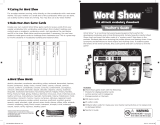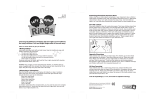Page is loading ...

EI-2535
Ages 6+/Grades 1+
Contents
• one 38.5" x 19.5" body chart
embroidered with organ outlines
• 16 self-stick organs
• 15 embroidered, self-stick labels
© 2008 Educational Insights, Inc., Rancho Dominguez, CA (USA).
Learning Resources, Ltd., King's Lynn, Norfolk (UK).
All rights reserved. Conforms to ASTM F 963.
Made in China. Please retain this information.
CUSTOMER SERVICE: (800) 995-4436 Monday–Friday
WEBSITE: www.Educational
I
nsights.com
My Body Health
Hold up some of the major organs (heart, lungs, stomach
and intestines) and ask students what they can do to help
these organs stay healthy. Students might suggest exercising
for a stronger heart, not smoking for healthy lungs, and
eating balanced meals to help the stomach and intestines.
Some students may know that excessive alcohol can damage
the liver. Students with diabetes may be aware that careful
monitoring of sugar intake will help the pancreas.
Caring for Your My Body Wall Chart
Clean the chart using a damp cloth and a mild
soap and water solution. The chart may be hung
using the grommets or may be pinned to a
bulletin board.

brain The brain is the control center of the whole body.
heart The heart pumps blood all over the body.
lungs The two lungs put oxygen in the blood.
trachea Air travels from the mouth through this tube to
the lungs.
esophagus Food travels from the mouth through this
tube to the stomach.
stomach Food is partly broken down here so the body
can then use the food’s energy.
liver The liver removes bacteria, alcohol, drugs, and old
blood cells from the bloodstream and helps with
digestion.
gallbladder The gallbladder stores and releases a
digestive chemical (bile) made by the liver.
spleen The spleen helps the body fight diseases.
kidneys The kidneys remove waste from the blood.
pancreas The pancreas helps with food digestion and
makes a chemical to digest sugar.
small intestine Food arrives here from the stomach and
is further broken down.
large intestine The large intestine gets water from
undigested food and then pumps the waste out of the
body. This organ is often called the colon.
bladder This is where urine is stored.
lnteractive Features
The ends of the trachea can be
inserted into the lungs. The end
of the esophagus can be inserted
into the upper end of the
stomach. The small intestine can
be inserted into the lower end of
the stomach. Encourage students
to open the heart to look inside.
Where does this organ belong? What organ is this?
Call students up to the front to individually place the organs
and/or the labels on the cloth chart. The embroidered
outlines on the chart help guide students in organ placement.
The back of each label has a number that coordinates with
the number on the chart to show correct label placement.
Pin the Heart on the Body
This is played like “Pin the Tail on the Donkey.” Put the heart
in the child’s hand. Twirl the student three times and then
release him/her two feet from the My Body Activity Center.
See where the student sticks the heart! You can play this
game with any of the body parts, and it’s a fun and amusing
way to reinforce correct organ location.
Guess the Body Part Riddles
Challenge students to guess which organ you’re describing.
Here are two examples.
1. Whoosh! This pair of organs puts oxygen in the blood.
(answer: lungs)
2.This powerful muscle pumps blood all over the body.
(answer: heart)
Classroom Activities
Using Your Chart
Introduce your students to the chart by pointing
out each organ and explaining its function.
/










